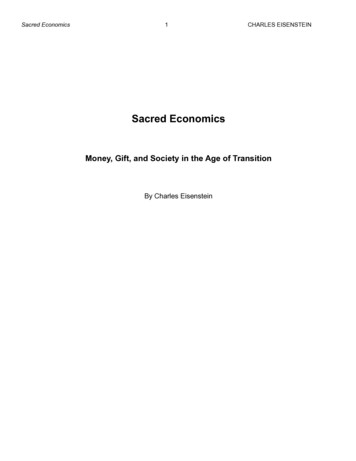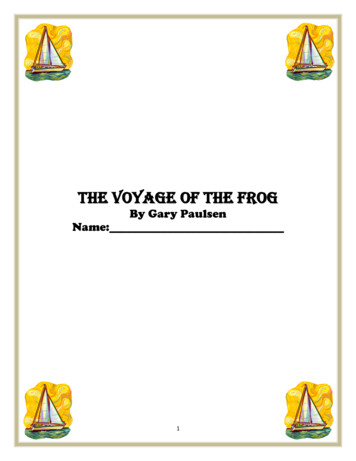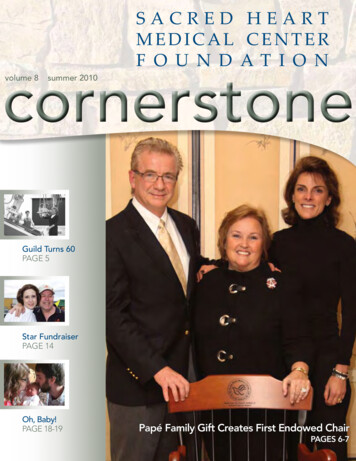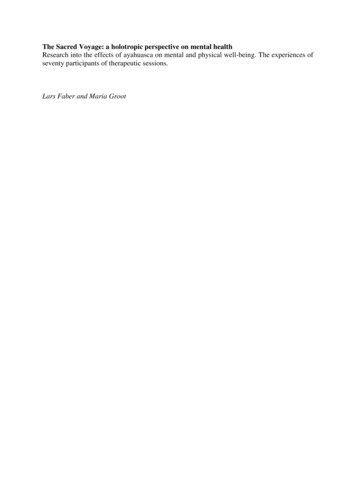
Transcription
The Sacred Voyage: a holotropic perspective on mental healthResearch into the effects of ayahuasca on mental and physical well-being. The experiences ofseventy participants of therapeutic sessions.Lars Faber and Maria Groot
Published by the foundation: In Search of EssenceOriginal publication in Dutch. Translation by Joost WaterborgWebsite: www.thesacredvoyage.comEmail: info@thesacredvoyage.comPainting “Eye of the world”, by Maria Groot2
ContentsDefinitionsSummaryForeword5681. Introduction112. The Sacred Voyage, a holotropic perspective on mental health2.1 Background2.2 Defining mental health2.3 Therapeutic aspects2.4 Shamanistic aspects2.5 Religious aspects2.6 Ritual aspects2.7 Non-Western aspects2.8 The importance of childhood2.9 Mythological aspects2.10 Somatic aspects2.11 Role of the activation cycle2.12 Focusing2.13 Intake2.14 Goal2.15 The use of ayahuasca2.16 arch design3.1 Research sample3.2 Set, setting and brew3.2.1 Set (intention, expectation, motivation)3.2.2.Setting3.2.3 Brew3.3 Parameters3.3.1 The actual experience3.3.2 Healing3.3.3 Transformation3.3.4 Positive effects of the transformation process3.3.5 Importance of guidance and preparation3.3.6 After-effects and physical effects3.4 Qualitative questions23232324252628282929293030304.Results4.1 Respons to the questionnaire4.1.2 Background of the respondents4.2. Previous experience4.2.1 Effects on physical and mental health4.2.2 Healing4.2.3 Transformational effect313131323233333
4.2.4 Positive effects of transformation4.2.5 Role of guidance and preparation4.2.6 After-effects and physical effects4.2.7 Participants’ view on the use of ayahuasca4.3 Qualitative onGeneral discussionBackground of the respondentsOccasionNature of the experienceEffects on mental and physical healthThe transformational effectTransformatiional experienceRole of guidance and preparationAfter-effects and physical effectsParticipants’ view on the use of ayahuascaRespondents personal experience of the VoyageTherapeutic effectsFuture6.Conclusions and recommendationsReferences6061Appendix 1: QuestionnaireAppendix 2: Quantitative responsesAppendix 3: Risk assessment of magic mushrooms657290About the authors4
DefinitionsAyahuasca:Ayahuasca is a Quechua word. Quechua is the language of the ancient Incas. There are manytranslations for the word ayahuasca, one of which is ‘little death’. Literally, the word means‘liana of the soul’, (‘aya’: spirit, ancestor or deceased person; ‘huasca’: liana), referring to theclimbing plant Banisteriopsis caapi, which supplies one of the main ingredients for theayahuasca brew. In Quechua, both plant and brew are known as ayahuasca.Set:Intention, expectations and motivation of the user.Setting:The context in which the use of ayahuasca takes place.Sacred Voyage:The Sacred Voyage is a rite of passage undergone to (re)find one’s own essence. It is amethod that consists of therapeutic, oriental meditative, shamanistic and spiritual/religiouselements. Through breathing techniques or an entheogenous agent, an alternative state ofconsciousness is reached. An emphasis on set, setting and preparation is characteristic for theSacred Voyage.Preparation:A thorough preparation for the Sacred Voyage means focusing and meditating on a theme(which is determined during a two hour intake session) which is relevant for the participant.Also, participants should fast for a minimum of three days prior to undertaking the Voyage.Healing:Beneficial to mental and physical health.Transformational:Allowing people to fulfil the ‘act of becoming’ through their own essence.Lasting positive effects:Those aspects that have noticeably and significantly improved for the participant in question,in comparison with their state prior to undertaking the Sacred Voyage.5
SummaryThis report documents the experiences of seventy people who, within the last two years, havetaken part in at least one, and at most four ayahuasca sessions in the setting of the SacredVoyage. Before the actual Sacred Voyage is made, an intake session takes place to determinewhat the participant’s theme is. The ayahuasca ceremony is held at the end of several weeksof preparation in which the participants meditate on their theme, focus on their intentions,stick to a prescribed diet and spend the last days prior to the ritual fasting. The ceremonytakes place in a one-day session with six to eight fellow Voyagers, and is led by twoexperienced guides.Over the last two years, 114 people have taken part in Sacred Voyage ceremonies. Thesepeople have been approached by email to request their participation in this research project.85 of them indicated their willingness to partake and a total of seventy respondents returnedthe quantitative and qualitative questionnaires within the requested time.The questions can be grouped into several categories, such as the participants’ backgrounds,prior experiences, the actual experience itself, the extent to which it is healing, thetransformational effects, the positive effects of the transformation process, the importance ofguidance and preparation, the aftereffects and the physical effects.The five final questions were of a qualitative nature and gave the respondents the opportunityto expand on the theme of their voyage, their expectations with regard to that theme and onwhether or not their expectations were met. Finally, respondents were provided with thechance to write about the results yielded by their ayahuasca experience, to make a statementabout the use of the brew and, if they were so inclined, to make any additional personalcomment.The participants’ backgrounds varied widely. Men were slightly outnumbered by femalerespondents, respondents had generally enjoyed advanced education and most had earlierexperiences in the field of personal growth and development. For most, the Sacred Voyageprovided their first encounter with entheogenous substances.The experience was described as healing or transformational by most respondents (resp. 74and 75%), 9% had a negative experience, 6% described a ‘bad trip’ and for 5 % the resultswere neutral. Virtually all respondents -including those reporting a negative experienceconsidered the use of ayahuasca in this setting as healing, or salutary for both their mental andtheir physical health.The transformational effect has been measured along the parameters of self-insight, selfacceptance, insight into one’s relationship with the world and with family, self-confidence,self-esteem, dealing with fears and the importance for personal development. Scores reportedfor these parameters, on a scale from one to ten, ten being the most favorable result, rangefrom 6.8 tot 8.8. The positive effects of transformation, such as feelings of oneness, feelinghappy, or happier, experiencing joy, love, energy of life, emotional stability, clarity of mindand calmness of spirit, feelings of connection with nature and insight into and connection withhigher things all scored in a range between 6.6 and 8.3. Here, reports of experiencing lovescored highest, while a connection with nature yielded the lowest results.The role of both preparation for and guidance of the Sacred Voyage were considered of greatimportance (score 8.9), as was the role of music, which scored 9 points.After drinking ayahuasca, most respondents experienced physical effects, of which nauseaand vomiting were the most common. In spite of these effects, the use of ayahuasca wasgenerally considered to be physically salutary.6
Most participants reported a heightened sensitivity to impressions from their environment fora number of days after their session. Negative aftereffects were mostly reported to have wornoff after fourteen days, while 60% of respondents considered the healing effects as longlasting.None of the participants regarded ayahuasca as a drug or even a part drug, most considered itto be a mind-expanding substance or a sacrament. Most would recommend the use ofayahuasca to others, provided that they had the proper motivation to use the brew.This report brings forth the conclusion that for many the use of ayahuasca within the settingof the Sacred Voyage, is a way to revive the connection with their own essence. In doing so,ayahuasca can provide a means of raising lives to a higher level of consciousness and wellbeing.7
ForewordThe first time I drank Ayahuasca is carved into my memory forever. In 1993 I was among theparticipants of a Santo Daime ritual in the German state of Bavaria. At these Santo Daimemeetings Ayahuasca, a bitter tea originating from South America, is drunk. Ayahuasca isfamous for its visionary qualities, and for the way it cleanses both body and soul. I had goneto this ceremony after being invited by a psychologist I had met at a San Franciscoconference.I was a bit of a ‘late-bloomer’. After having witnessed a considerable number of friends losetheir mind in the sixties and seventies, the results of what was known as a ‘bad trip’, I decidedto keep a respectful distance from what were considered to be consciousness-expandingsubstances. It had become clear to me that these substances could help expand the mindconsciousness but it was equally clear that this alleged shortcut to insight could come withsome unexpected risks. My experience as a counselor in a therapeutic community for drugaddicts had also given me an up close look at the daunting images of the havoc addictivedrugs can wreak on human life. However, I do not hold the opinion that all drugs arenecessarily harmful.Unfortunately, the view that drugs are by definition destructive dominates public opinion witha saddening tenacity. This view unjustly ignores the centuries of experience in usingharmony-enhancing, consciousness-expanding plants. Unfamiliarity with these favorableaspects is what distorts any debate on the use and merits of entheogenous (‘awakening thedeity within’) plants.I myself have also been confronted with my fair share of incomprehension towardsAyahuasca, especially when I attempted to travel through customs, going from Brazil to TheNetherlands, carrying several gallons of Ayahuasca in jerry cans. With sweaty hands I tried tobring Ayahuasca into the country for the Santo Daime religion for the very first time. At thetime, Ayahuasca was positively illegal and importing it could mean serving several years inprison. The Justice Department did not know that this brew had a history of millennia of usein religious rituals in the Brazilian Amazon, among other places. They were also unawarethat, in Brazil, Ayahuasca plays an essential part in a recognized religion.But let’s jump back to Germany, where I experienced my first Ayahuasca ritual with somefriends. After having sung several songs in an indiscernible tongue (which later turned out tobe Brazilian Portuguese), the other participants suddenly burst out in enthusiastic Germansinging. My first thought was: “Where have I ended up? It’s almost like I’m in the war,surrounded by Bavarians”. At the same time the leader of the ceremony sternly looked myway and said -fortunately in English-: “No, we are not Nazis!” Being taken aback by the factthat my thoughts were apparently out there open to everyone, I suddenly realized one of thealternative names for the Ayahuasca brew I had just taken: ‘telepathine’. The illusion thatthoughts are there only for private use suddenly belonged to the realms of history.The experience at this ceremony spurred me on to travel to Spain, where Padrinho Alfredo,the leader of the Santo Daime religion attended a European meeting. I was provided with theopportunity to invite him for a visit to The Netherlands. He accepted my invitation and visitedthe following year.In Spain, I witnessed for the first time how important and powerful the ritual setting is forguiding the contents of people’s consciousness, awakened by the Ayahuasca, to their properdestination.It is well-known that consciousness-expanding substances can release these contents of man’sawareness. However, what should be done with this energy, the emotions and the visions that8
are released? Without adding structure to the experience, only those truly strong of body andmind may afterwards be able to regain a firm foothold. Repressed trauma, emotionalblockades, questions of meaning in life, sickness and health, oneness and harmony, or theiropposites; these are all issues that are brought to the surface by consciousness-expandingsubstances.In Leiden, Holland, the well known Prof. Dr. Bastiaans gained international reputation forusing LSD to have his heavily traumatized patients, WWII concentration camp survivors,relive their memories and deal with them. One of Bastiaans’ colleagues, the Czechpsychiatrist Dr. Stanislav Grof performed an incredible feat by managing to document, undera communist regime, the experiences his patients in a psychiatric institution had under theinfluence of LSD. It was remarkable in its own right that his patients reported near-deathexperiences, rebirthing, memories of their natural birth, past deaths and reliving a whole rangeof spiritual and traumatic experiences. The fact that Grof was not only courageous enough toplace his patients’ experiences in the foreground, but also rejected the communists’ strictlyatheist paradigm is a true litmus test for any entheogenous experience. Courage is absolutelyindispensable when stepping into worlds that normally remain closed. By recognizing thesetranspersonal experiences the traditionally trained psychiatrist placed himself outside thedominant scientific paradigm that only acknowledges a material origin of consciousness.My personal experiences with the now formally founded and registered Santo Daime churchin The Netherlands were by all measures tempestuous. A wide interest for this form ofreligious experience proved to exist. During a visit to Holland by a group of Brazilians itturned out that the police were also thoroughly interested in our affairs. Police raids of SantoDaime churches throughout Europe, coordinated by Europol, were executed simultaneously.Church leaders were arrested, and it was especially bizarre to find out that I was being takento a prison holding unit where I had once worked as a consultant for the Justice Department,motivating drug addicts to lead a drug free existence. Civil servants threateningly ensured usthey would ‘put us away for years’. Fortunately I had done a lot of preparational work,allowing our fully settled in attorney Adèle van der Plas to swiftly turn up to submit thechurch statutes and the relevant references to leading academic experts on these specificmatters. In the anxiously anticipated trial at an Amsterdam Court the scientific statementsproved to be of overriding importance for the legalization of the Dutch Santo Daime church.It cannot be overemphasized that the seal on entheogenous plants, formed by the Europeandrug legislation, can only be broken by the words of science. Most European states followedthe Dutch lead and legalized and formally acknowledged the Santo Daime religion, which isnow represented in almost every European country. Regular religious meetings are heldthroughout Europe, sometimes bringing together hundreds of participants.This introduction is essential to sketch the historical frame of reference from which theWestern world traditionally regards alterations of consciousness through the use ofentheogenous. The Santo Daime church had the benefit of being able to lean on an ancientSouth American tradition of using entheogenous plants. The interesting thing about the workof Lars Faber is the direct inspiration he finds in Ayahuasca. From its astral dimension ithelps him to find a direction in his work and to define the contents of his writings. This is aninteresting development and should, in my view, be subject to the same rights and conditionsas those that apply to existing recognized church communities. It goes without saying thatpeople’s actions should be accounted for in processes that deeply affect one’s most intimateand personal levels. Lars has initiated this through sound scientific research. This research is anecessary condition for enabling us to retain the birthright to expand our consciousnessthrough the use of entheogenous plants.9
The following research report documents the findings of research conducted by Lars Faberand expert Dr. Maria Groot, research into the experiences of seventy clients of Lars’s SacredVoyage practice. This solid approach is testimony to the intention to use the Golden Keyresponsibly. The Golden Key here represents the well-informed use of entheogenous in areligious and therapeutic setting. Lars’s paper is the tangible form of the need for theoreticaleducation in these matters, required, in conjunction with practical experience, to be able to dothis important work. Transpersonal psychology recognizes a wider framework than thelimited theories in the fields of conventional psychology and psychiatry. Lars’s books haveshown him to be well-versed in the transpersonal views, a basic requirement for any therapistaiming to work with the Golden Key. The combination of a strong entheogenous agent and asolid therapeutic approach may prove a promising Key in the right hands, enabling the user totransform a great deal of suffering.The ‘bad trip’ phenomenon (resulting from too much information, use at an inopportunemoment, in the wrong circumstances, and/or without the right guidance) is largely caught outthrough a phase of sound preparation. Through a structured interview about the potentialparticipant’s medical and psychological condition, many risks are brought down to acceptableproportions. The research shows that even people who underwent negative experiences duringtheir Voyage later regarded these as useful learning opportunities. This goes to show thatproper preparation, context for interpretation, surroundings and guidance are of decisiveimportance for any entheogenous experience.This report, written by Lars Faber and Dr. Maria Groot, doesn’t merely present the drystatistics that accompany any scientific effort. Rightly so, a lot of space has been reserved forthe verbatim accounts of Sacred Voyage participants. Some critical remarks aside, thedominant response reflects how amazement abounds at the possibilities that arise for newperspectives and a new way of living.The entheogenous path of learning has a lot of potential for harmony and healing for thosepeople out to find them. This work may hand many a person the handles to the meaning ofAldous Huxley’s use of William Blake’s quote in The Doors of Perception: “If the doors ofperception were cleansed every thing would appear to man as it is: Infinite” (William Blake,The Marriage of Heaven and Hell). Lars Faber’s use of this quote in his book “The SacredVoyage” is very significant, as he uses it to indicate the aim of his labors. That theentheogenous experience under the right guidance and the right conditions may help to castnew light on the world is the message of every truly Sacred Voyage.I hereby wish to express my sincere hope that the brave workers beating this new track will begiven all the support that is needed. Support from both the material and the spiritualdimension.Hans Bogers, co- founder of Santo Daime The NetherlandsWassenaar, July 200810
1 IntroductionAyahuasca is an entheogenous brew from the Amazonian rainforest and is used by localshamans. It is also used in rituals of the Santo Daime church. This report documentsayahuasca’s use for therapeutic purposes in a standardized setting. In chapter two, we willdiscuss our holistic view on mental health, which is the starting point for the Sacred Voyage.Chapter three describes the research design, the research sample, the questionnaire and theparameters that are assessed. This is followed by the results of the survey, in chapter four,which presents tables of the quantitative and gives a general impression of the qualitativeresults, which are given in full in appendix 2. Chapter five discusses the survey results andcompares them with findings of earlier studies in this field. Finally, chapter six holds ourconclusions and recommendations.2 The Sacred Voyage: a holotropic perspective on mentalhealth2.1 BackgroundOver the last few years we have acquired a wealth of experience in the therapeutic guidanceof people who have used ayahuasca within the setting of the Sacred Voyage. This experienceconvinced us that the method on which we report through this medium, is beneficial topeople, provided the method is applied under the right conditions. This method has beendubbed ‘the Sacred Voyage’ and is based on the controlled, effective and safe use of theentheogenous brew ayahuasca, which finds its origins in the Amazonian rainforest.The Sacred Voyage method was developed by Lars Faber and consists of therapeutic, orientalmeditative, shamanistic and spiritual/religious elements. The book that accompanies themethod and goes by the same name, has the subtitle ‘the pilgrimage to the soul’. The maingoal of the Sacred Voyage method is to help people get in contact and develop a lastingrelationship with their essence (also known as their true self, inner Child or Divine Child).Ayahuasca is a brew which originated in the Amazonian region and was first discovered bythe rainforest’s native inhabitants. We feel obliged to express our respect and gratitude to theshamans in ‘the world’s breeding ground’ for making ayahuasca available to Westerners. Tothese shamans, ayahuasca, known to them as the ‘Mother of all Medicine’, is a holysacrament, serving many purposes. Ayahuasca is used for spiritual initiation rituals, asmedication, to induce clairvoyancy, for astral travel and for relaxation.It has been known for some time that ayahuasca possesses some special medical qualities, ashas been testified in earlier publications. As Dr. Charles Grob concluded from his 1993Hoasca project: ‘“Ayahuasca is perhaps a far more sophisticated and effective way to treatdepression than SSRIs [antidepressant drugs],” Grob concludes, adding that the use of SSRIsis ‘a rather crude way’ of doing it. And ayahuasca, he insists, has great potential as a longterm solution.’11
One of the articles about the healing properties of ayahuasca, which received worldwideattention, was written for National Geographic by Kira Salak and covers Salak’s personalexperience with the brew. She describes how an ayahuasca cleansing ritual helped heraccomplish what years of psychotherapy had failed to deliver. A day-long ayahuasca ritual ridher of a heavy depression. Lars Faber experienced a similar feat and has written “The SacredVoyage” to describe the process he underwent. Later, dozens of other people would reporthaving had similar experiences after using ayahuasca under his therapeutic guidance.In spite of the promises associated with ayahuasca, little interest has been shown by thescientific fields of medicine and psychiatry. In this day and age, treating symptoms andprescribing medication like antidepressants seems to be an easier approach than trackingdown and actually curing the source of the ailment, even though for shamans, this is ‘all in aday’s work’.This paper reports on an effect which cannot be measured, explained, proven or replicated indouble-blind, randomized, placebo-controlled studies, not only because it does not deal solelywith average scores but also because it is contingent on highly individual psychological andsomatic processes. The common denominator of these processes is that, despite theindividually unique path people travel along, the goal is always the same: to find one’spersonal essence and fulfill ‘the act of becoming’.These goals, and their fulfillment, can only be assessed introspectively by the individual inquestion. However, because the phenomena at hand are often described as healing,transformational and even as peak experiences, the individual contributions to this researchseem worth reporting and delving into more deeply.This report will cover the findings of those who have experienced the use of ayahuasca in thesetting of the Sacred Voyage, as well as the conditions under which the therapeutic sessionstake place. The main focus will be on the results achieved by clients in the fields of personalgrowth and emotional well-being. The data used to assess these phenomena have beenacquired through both quantitative and qualitative research, targeting clients of the SacredVoyage therapeutic practice.The data provided to us by our clients who were willing to share their most intimate andpersonal processes of awareness with us, have been treated with the utmost integrity.Assuming that the words connected to the experiences of our clients will speak forthemselves, we feel strengthened to report in this manner, which we recognize as rathersubjective. However, a factor of objectivity in this research is that clients only report inretrospect. It was not until late in 2007 that we decided to approach our clients for theirpersonal and entirely voluntary contribution to this project. We have chosen this retrospectiveapproach to prevent us from influencing or tainting the therapeutic processes and experiences.Our gratitude goes out to those seventy volunteers who have granted us a glimpse of theirhighly personal developments.2.2 Defining mental healthMental health: A quality of fully fledged human existence, being more than a mere absence ofpsychological and psychiatric disorders and more than a standard measure for assessing the12
mental health of an individual. (The term quality does not refer to a generic and objectivenorm for mental health itself, but to the more normative nature of the term mental health.)The operational method of the Sacred Voyage uses Trimbos’s 1959 definition of mentalhealth, being: ‘a quality of human existence’.2.3 Therapeutic aspectsIn the process of rediscovering and awakening the personal essence, the Sacred Voyage is arite of passage, which supports people in the act of becoming. Here, the major assumption ismade that when people are out of touch with their essence, feelings of discontent, depressionand other psychological and somatic symptoms and complaints may arise. Ergo, when peopleare able to re-establish the contact with this essence, and build a lasting relationship with it,the symptoms and complaints can disappear and the individual can fulfill the act of becoming.When an individual has not fulfilled his or her act of becoming, negative feelings such asdepression and melancholy and ‘negative’ emotions such as anger, anxiety and grief maydominate this person’s life. When an individual fulfils the act of becoming, feelings of love,peace and happiness can arise and life can become characterized by meaningfulness andaimed at connecting with others.2.4 Shamanistic aspectsRather than on targeting the negative, our operational method aims to promote the positive,which presents itself in the form of emotions, feelings, thoughts and symptoms. This holisticapproach is deeply rooted in the shamanistic traditions and views, as the following excerptfrom “The Shaman’s Last Apprentice” illustrates. Shaman Don Juanito:“Disease is only a wake up call to start living.”“I don’t understand.”“Well, you see Rebekita, when we are attached to illness we only focus on disease. We forgetto see life as a journey where everything is flowing in motion, so that illness and disease areactually opportunities for growth.”“I’m still not sure I understand.”“Disease is the spirit’s way of expressing that it is unhappy and in pain, and that it can nolonger be ignored. Most people become distressed by illness, and this only increases sufferingbecause our fear of death causes us to fear disease. We have been taught to believe that deathis punishment, and if we are good people we will not get sick, or we will be cured. It is timewe start to embrace death and accept it as part of the inevitable experience of life. Illness is achance to make life changes, to start really living. It gives us the opportunity to rememberwhat is important in our lives, to follow our dreams, to heal old wounds and say goodbye.Illness empowers the spirit to be heard and to show the way to a more fulfilling life, forhowever long that is.”Further on in “The Shaman’s Last Apprentice”, the shaman says:“The Amazonian plant, the Mother of all Medicine, Ayahuasca, will teach you to love andaccept yourself. But first you must go deep within to heal your own pain and suffering. Trueshamans first learn to heal themselves before they can heal others. This is Ayahuasca’s gift.”13
In our holistic perspective we embrace this shamanistic approach to the healing of pain andsuffering, in which ayahuasca plays a major part. In our views, this approach offers openingsto a better life. Instead of emphasising the negative, and attempting to eliminate it (be it withor without the use of medication), which is common in the conventional Western approach tomental health, we welcome the symptoms experienced by our clients, regarding them as anopportunity in fulfilling the act of becoming. This research project will not focus on thesesymptoms, stressing their possible disappearance, but will emphasise the effects of theayahuasca experience on certain parameters associated with mental health. These parameterswill be defined elsewhere.2.5 Religious aspectsAs far back as early Christian mysticism, references have been made to the ‘original image’or ‘true face’. Charles L. Whitfield described the phenomenon of our essence as follows:‘Who we are when we feel at our most authentic, real or impassioned.’ Our essence possessesqualities such as spontaneity, vulnerability, creativity and especially vitality. When we are intouch with our essence, we feel alive. From our own essence, we connect with others and wemay shap
The Sacred Voyage: a holotropic perspective on mental health . love, energy of life, emotional stability, clarity of mind and calmness of spirit, feelings of connection with nature and insight into and connection with higher things all scored in a rang

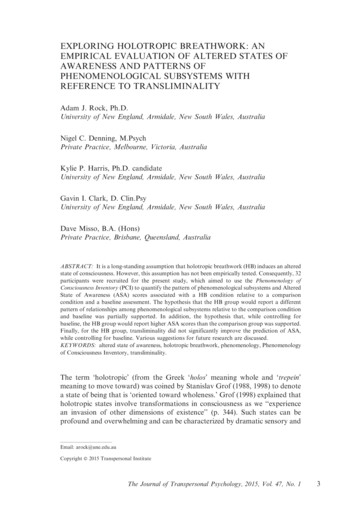
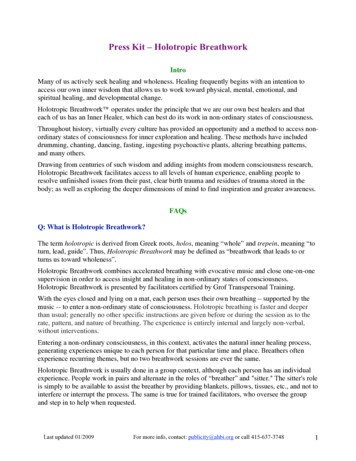
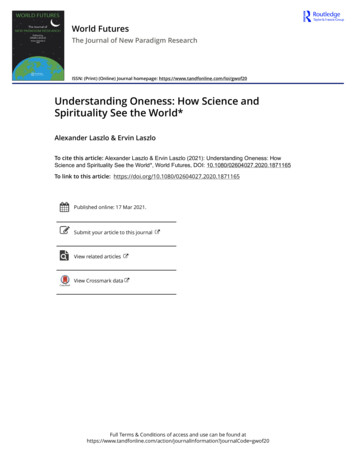

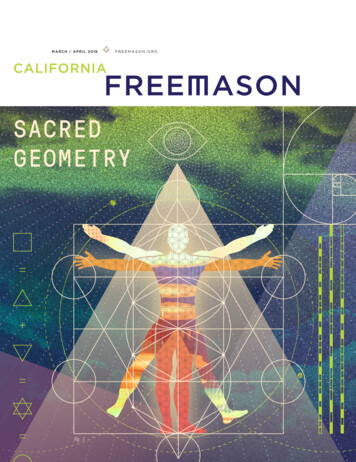
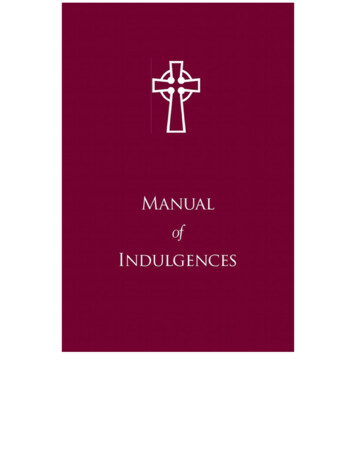
![The Book of the Damned, by Charles Fort, [1919], at sacred .](/img/24/book-of-the-damned.jpg)
